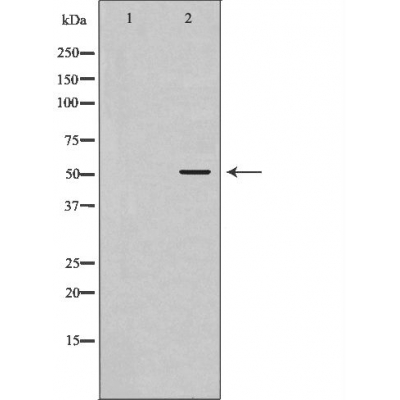ATG4C Antibody - #DF6259
| Product: | ATG4C Antibody |
| Catalog: | DF6259 |
| Description: | Rabbit polyclonal antibody to ATG4C |
| Application: | WB IHC IF/ICC |
| Reactivity: | Human, Mouse, Rat |
| Prediction: | Pig |
| Mol.Wt.: | 52kDa; 52kD(Calculated). |
| Uniprot: | Q96DT6 |
| RRID: | AB_2838225 |
Product Info
*The optimal dilutions should be determined by the end user.
*Tips:
WB: For western blot detection of denatured protein samples. IHC: For immunohistochemical detection of paraffin sections (IHC-p) or frozen sections (IHC-f) of tissue samples. IF/ICC: For immunofluorescence detection of cell samples. ELISA(peptide): For ELISA detection of antigenic peptide.
Cite Format: Affinity Biosciences Cat# DF6259, RRID:AB_2838225.
Fold/Unfold
APG4 autophagy 4 homolog C (S. cerevisiae); APG4 autophagy 4 homolog C; APG4 C; APG4-C; APG4C; ATG 4C; ATG4 autophagy related 4 homolog C (S. cerevisiae); ATG4 autophagy related 4 homolog C; Atg4c; ATG4C_HUMAN; AUT (S. cerevisiae) like 1, cysteine endopeptidase; AUT like 1, cysteine endopeptidase (S. cerevisiae); AUT like 1, cysteine endopeptidase; AUT like 3 cysteine endopeptidase; AUT-like 3 cysteine endopeptidase; AUTL1; AUTL3; Autophagin 3; Autophagin-3; Autophagy related 4C cysteine peptidase; Autophagy related cysteine endopeptidase 3; Autophagy related protein 4 homolog C; Autophagy-related cysteine endopeptidase 3; Autophagy-related protein 4 homolog C; Cysteine protease ATG4C; EC 3.4.22; FLJ14867; OTTHUMP00000010715;
Immunogens
- Q96DT6 ATG4C_HUMAN:
- Protein BLAST With
- NCBI/
- ExPASy/
- Uniprot
MEATGTDEVDKLKTKFISAWNNMKYSWVLKTKTYFSRNSPVLLLGKCYHFKYEDEDKTLPAESGCTIEDHVIAGNVEEFRKDFISRIWLTYREEFPQIEGSALTTDCGWGCTLRTGQMLLAQGLILHFLGRAWTWPDALNIENSDSESWTSHTVKKFTASFEASLSGEREFKTPTISLKETIGKYSDDHEMRNEVYHRKIISWFGDSPLALFGLHQLIEYGKKSGKKAGDWYGPAVVAHILRKAVEEARHPDLQGITIYVAQDCTVYNSDVIDKQSASMTSDNADDKAVIILVPVRLGGERTNTDYLEFVKGILSLEYCVGIIGGKPKQSYYFAGFQDDSLIYMDPHYCQSFVDVSIKDFPLETFHCPSPKKMSFRKMDPSCTIGFYCRNVQDFKRASEEITKMLKFSSKEKYPLFTFVNGHSRDYDFTSTTTNEEDLFSEDEKKQLKRFSTEEFVLL
Predictions
Score>80(red) has high confidence and is suggested to be used for WB detection. *The prediction model is mainly based on the alignment of immunogen sequences, the results are for reference only, not as the basis of quality assurance.
High(score>80) Medium(80>score>50) Low(score<50) No confidence
PTMs - Q96DT6 As Substrate
| Site | PTM Type | Enzyme | Source |
|---|---|---|---|
| M1 | Acetylation | Uniprot | |
| K15 | Ubiquitination | Uniprot | |
| S18 | Phosphorylation | Uniprot | |
| Y25 | Phosphorylation | Uniprot | |
| S164 | Phosphorylation | Uniprot | |
| S166 | Phosphorylation | Uniprot | |
| K179 | Ubiquitination | Uniprot | |
| T181 | Phosphorylation | Uniprot | |
| Y185 | Phosphorylation | Uniprot | |
| S186 | Phosphorylation | Uniprot | |
| S369 | Phosphorylation | Uniprot | |
| S381 | Phosphorylation | Uniprot | |
| T383 | Phosphorylation | Uniprot | |
| Y387 | Phosphorylation | Uniprot | |
| S398 | Phosphorylation | Uniprot | |
| K403 | Ubiquitination | Uniprot | |
| S451 | Phosphorylation | Uniprot | |
| T452 | Phosphorylation | Uniprot |
Research Backgrounds
Cysteine protease required for the cytoplasm to vacuole transport (Cvt) and autophagy. Is not essential for autophagy development under normal conditions but is required for a proper autophagic response under stressful conditions such as prolonged starvation (By similarity). Cleaves the C-terminal amino acid of ATG8 family proteins MAP1LC3 and GABARAPL2, to reveal a C-terminal glycine. Exposure of the glycine at the C-terminus is essential for ATG8 proteins conjugation to phosphatidylethanolamine (PE) and insertion to membranes, which is necessary for autophagy. Has also an activity of delipidating enzyme for the PE-conjugated forms.
Cytoplasm.
Highly expressed in skeletal muscle, heart, liver and testis.
Belongs to the peptidase C54 family.
Research Fields
· Cellular Processes > Transport and catabolism > Autophagy - other. (View pathway)
· Cellular Processes > Transport and catabolism > Autophagy - animal. (View pathway)
Restrictive clause
Affinity Biosciences tests all products strictly. Citations are provided as a resource for additional applications that have not been validated by Affinity Biosciences. Please choose the appropriate format for each application and consult Materials and Methods sections for additional details about the use of any product in these publications.
For Research Use Only.
Not for use in diagnostic or therapeutic procedures. Not for resale. Not for distribution without written consent. Affinity Biosciences will not be held responsible for patent infringement or other violations that may occur with the use of our products. Affinity Biosciences, Affinity Biosciences Logo and all other trademarks are the property of Affinity Biosciences LTD.
